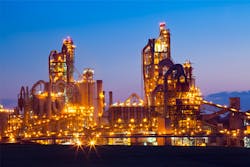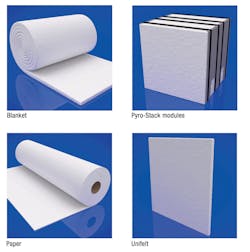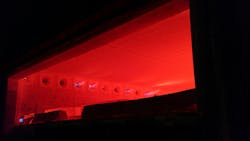A viable replacement for refractory ceramic fiber
Refractory ceramic fiber (RCF), also known as aluminosilicate wool (ASW), has long been the first-choice material for lining fired heaters in the oil refining and petrochemical industries. It has excellent handleability, low thermal conductivity and heat capacity; superior thermal shock resistance; good resistance to pollutants; and ability to withstand extreme temperatures. These qualities make it ideal for extending the life of fired heaters, increasing their energy efficiency and increasing furnace reliability.
However, some in the industry are always looking for alternatives to RCF. European Union (EU) regulations designed to address the health concerns of RCF and crystalline silica have required materials manufacturers to search for innovative solutions to put minds at ease and introduce furnace linings fit for the future.
Under the EU Carcinogen Directive, businesses are required to use substitutes to RCF where it is technically and economically feasible to do so. These requirements, however, are open to interpretation and until recently, no material has been able to match the superior insulating performance and high melting point of RCF.
Replacing RCF: a balancing act
For many oil refinery operators, replacing RCF with alternatives will negatively affect furnace operations, making it an unpopular option. A typical furnace can generate between £100,000 (approximately $130,000 USD) to £1m ($1.3 million USD) worth of product in a single day; a figure that leaves many operators having to weigh the pros and cons between their bottom line and complying with EU regulation.
On the opposite face of the coin, many operators value their green and ethical approach. Some are maintaining the fired heater’s lining to extend its lifespan rather than replacing it, in the hope that a viable RCF alternative will be made available. However, this conscious decision may be taken at the expense of an efficient and high-performing furnace.
From 2020 onward, producers and users of RCF in Europe will have to keep the amount of RCF fibers in the workplace <0.3 fibers/ml. Many other countries around the world have imposed similar stringent controls. Such controls make using RCF difficult and expensive. Disposal of RCF is also becoming expensive, requiring special landfill sites.
This is compounded by the increasing commitment of major industrial companies and trade associations to improve "green" standards and places the onus on the fiber industry to find viable alternatives that match the performance of RCF. For example, RCF has been more resistant to attack by alkali-based pollutants than the existing low-biopersistent (LBP) fiber compositions and that has limited the replacement of RCF in many applications.
An alternative to RCF
In recent years, Morgan Advanced Materials has conducted research into RCF alternatives at its Fibre Centre of Excellence in Bromborough, United Kingdom. Instead of attempting to make marginal gains in LBP performance, Morgan has flipped its approach and revisited RCF itself. The ideal outcome has been to produce a new fiber with all the great performance of RCF but that has low biopersistence and that does not form crystalline silica during use. As a result, Morgan’s Thermal Ceramics business recently launched a material that performs in a similar way to RCF without the inherent environmental, health and safety (EHS) risks associated with it.
The material branded as Superwool XTRA is unique in that it does not form crystalline. In terms of its effect on EHS, the material is exonerated from any carcinogenic classification under Nota Q of Directive 97/69EC.
From strength to strength
Superwool insulating fiber was first launched in the 1990s. Since then, it has become recognized for its LBP properties that minimize health risk to furnace installers, operators and other factory employees. The latest material in this family delivers strength in terms of its resistance to high temperatures and pollutants, but also its improved EHS credentials.
The newest material was the culmination of almost a decade of research and development, plus almost four years of stringent testing in specified applications with customers.
Crucially, petrochemical operators are guided by the American Petroleum Institute’s (API) standards. The API’s temperature classification rating to be used for insulation outlines an obligatory 150°C overtemperature capability on the fiber within furnaces.
Critical furnaces within the oil refining and petrochemicals industry run between 1,200°C and 1,250°C (2,192°F and 2,282°F) and therefore require materials with a 1,400°C (2,552°F) minimum classification rating. With a classification rating of 1,450°C (2,642°F), the newly developed material offers a performance equal — and in many cases superior — to RCF.
Superwool XTRA lining materials in a variety of forms, from blanket, to Pyro-Stack modules, to paper and unifelt.
Making the switch
Identifying the need for a new furnace lining is not an easy task as testing and trialling new materials can cost upward of £30,000 (approximately $39,000 USD) per trial, not to mention furnace downtime. Ensuring lining quality, however, is essential for protecting personnel, minimizing heat loss and maintaining operational reliability.
Furnace linings, which may have developed cracks over time, are prone to increased thermal loss; some of which may not be visible from the outside. To minimize costs, it is recommended that testing coincides with the scheduled downtime, so fabricators can swap out and install the new lining.
One technique for identifying thermal losses lies in the use of infrared (IR) thermography scans. By using IR scans, engineers can keep the furnace in operation while conducting an analysis. If a hot-spot leak is found, it is best to repair it on-line, if possible, to lessen business impact.
Consider engineering design carefully
To achieve maximum efficiency for the materials specified during the furnace relining process, it is critical to ensure the engineering design is appropriate.
Not only must the materials have enough studs to hold them in place, they also require sufficient joints for expansion or shrinkage. If a brick lining is installed without adequate expansion joints, the brick can grow so large that it pushes the entire lining off the furnace wall. This will lead to further inefficiency, requiring the entire process to be repeated.
Over long periods of time at temperature, fiber modules degrade, resulting in shrinkage gaps between the modules. These normally need filling with more fiber during scheduled maintenance shutdown periods. With the newly developed material, the fiber expands when heated to high temperatures such that any shrinkage gaps remain closed. This expansion is reversible so when it cools down, the shrinkage gaps become visible. However, unlike other fibers, there is no need to fill the gaps, saving on labor costs, material and downtime.
A typical brick-fired heater in operation. RCF, also known as aluminosilicate wool (ASW), has long been the first-choice material for lining fired heaters in the oil refining and petrochemical industries.
Trust the professionals
A new furnace lining that uses the right materials, is designed to requirements and is installed correctly can last up to 20 years. Therefore, ensuring it performs efficiently and reliably is imperative. With a vast range of furnace lining products available on the market, each requires unique installation methods, so it is important that the people carrying out the work are highly skilled and experienced. Failing to install correctly can lead to complications, excessive downtime and great financial loss.
Additionally, degradation of furnace insulation can result in development of hot spots on the casing, which can damage equipment and cause an unsafe working condition for personnel. It can also disrupt the process as operators compensate for the higher heat loss. In turn, the furnace can develop hot spots that if located near its tubes, could cause serious damage. This can be extremely dangerous, as the materials in these tubes are highly flammable. If the tubes break, there is a significantly heightened risk of an explosion.
A brighter future
The industry’s search for an RCF alternative is now over and a LBP future for refineries and petrochemical plants has arrived in selected applications.
The new alternative to RCF has proven itself through considerable testing and real-world applications to be a viable alternative, with no loss of thermal performance. In addition to its efficiency credentials, the product’s improved EHS performance and lack of crystalline silica as a by-product have alleviated worries from operators and installers at petrochemical sites. It is available in multiple forms and able to provide LBP thermal insulation to the iron and steel, glass and ceramics industries as well as the chemical processing and oil and gas sectors.
Gary Jubb is Fibre Centre of Excellence Lead at the Thermal Products Division of Morgan Advanced Materials, a global materials engineering company, which designs and manufactures a wide range of high specification products with extraordinary properties, across multiple sectors and geographies. Educated at the University at Bradford in the United Kingdom, Jubb has a degree in materials science and a doctorate in magnetic materials. He has worked in research and development for Morgan for 31 years, with the last 28 years focused on developing Thermal Ceramics’ extensive range of low-biopersistent, high-temperature fibers. He recently relinquished managing these projects to lead the Fibre Centre of Excellence.


